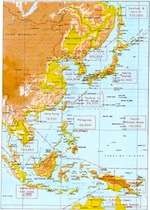Shortly after the signing of the Instrument of Surrender, General of the Army Douglas MacArthur, now Supreme Commander for the Allied Powers issued his General Order No. 1, which was transmitted to Japanese forces by the Imperial General Headquarters. The Act of Surrender and the General Order were military directives that established procedures for demobilizing Japanese forces, not Japanese territories, and they were not meant to settle political issues. The order laid out the measures for the surrender of all Japanese forces in three theaters, China, Indochina, and Formosa. According to a report submitted by Japanese Headquarters, there were over 1,385,00 Japanese troops, and half a million Japanese civilians in the theaters of China (excluding Manchuria), Indochina (north of the 16th parallel), and the Island of Formosa (now called Taiwan). < Click Map left for repatriation numbers. |
Surrender In The China Theater |
GEN Ho Ying-chin, Commander in Chief of the Chinese Army, transmitted his Memorandum of Surrender to Gen. Okamura Yasutsugu, Commander of Japanese Forces in the China Theatre. Following the hostilities there were over 60,000 U.S. troops in the China theater, and by September an additional 50,000 U.S. Marines were deployed to assist in controlling the ports, railroads, and airfields. By the end of December 1945, over one million Japanese troops were interned and ready for repatriation. |
Surrender In Indochina |
GEN MacArthur’s General Order No. 1 divided Indochina (Vietnam, Cambodia and Laos- then called the Kingdom of Luang Prabang) at the 16th parallel, and gave the responsibility for accepting the Japanese surrender to Generalissimo Chiang Kai-shek in the north, and Great Britain in the south. The British would eventually return control of the south to the French reestablishing their colonial rule. North Vietnam (then called Cochin China) fell under the control of the nationalist Vietminh Guerilla’s, led by Ho Chi Minh, a devout communist. |
Surrender In Formosa |
GEN Isayama Haruki, Japanese Chief of Staff on Formosa (now called Taiwan) and representing their Governor-General, flew to Nanking, China to surrender the island to five prominent Formosans on 9 September. Formosa was not considered Chinese territory in the Act of Surrender. It was distinguished from China, and listed alongside French Indochina as an area to be disarmed by GEN Chiang Kai-shek. |
Surrender In South Korea |
To act as a deterrent to counter any plans of Soviet expansion GEN MacArthur ordered LG John R. Hodge to land his XXIV Corps (Okinawa) at Inchon, and oversee occupational duties. The U.S. Navy put the troops ashore at Inchon Harbor on 8 September. On the following day of 9 September, the Japanese forces in the southern part of the Korean peninsula surrendered in ceremonies held in the Government Building at Keijo (Seoul). The surrender marked the end of three and a half decades of Japanese oppressive rule in Korea. The peninsula north of the 38th parallel was already in the hands of the Communist Soviet (Russian) Army. |
Japanese Troops In U.S. and Allied Detainment Camps |
There were also tens of thousands of Japanese troops being held in Allied detainment camps throughout the southwest Pacific Theater that were captured during the island hopping campaign, they would also be repatriated to their home islands. |
